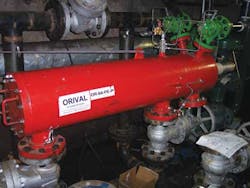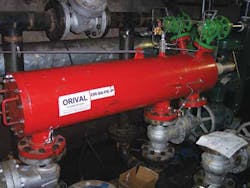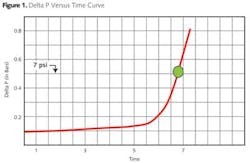By Marcus N. Allhands
The air quality in the Big Apple can result in some pretty substantial problems with rooftop cooling towers for commercial HVAC systems. Twenty years ago the owners of a large uptown commercial building on Madison Avenue in New York City decided to include an automatic self-cleaning screen filter in their new HVAC system to ward off likely problems with water quality.
Today the big roof-mounted 900 ton cooling tower continues to acts as a large community air cleaner. Pollen, dust, insects and smoke are scrubbed from the atmosphere by the large tower. Over 40 water cooled package units use the cooling tower to condition the indoor air of this commercial building. The protection provided by the filtration system is what convinced management to replace the initial installation with an improved product 15 years later.
When the 28-story building was constructed, three fixed speed 1200 gpm pumps supplied water from the cooling tower to 25 direct expansion water cooled package comfort units ranging in size from 14-30 tons each. In addition, nearly 20 smaller 1-5 ton similar package units were supplied water from the same tower to cool computer rooms throughout the building. Two pumps ran continuously year-round while the third was for back-up. The building's control system for HVAC was designed to maintain a fixed pressure differential (ΔP) between the supply and return water. As package units went on and off line, a by-pass valve would be controlled to maintain the preset ΔP.
In 2002, the system was upgraded with a new Orival Model OR-10-PE Automatic Self-cleaning Screen Filter with 10-inch inlet and outlet flanges designed for 1800 gpm flow rate. The screen was of 316L stainless steel weave-wire construction with a filtration degree of 100 microns. This screen contained 9200 cm2 of surface area. Just prior to the new filter installation, the owners replaced the existing three supply pumps with 50 hp VFD pumps to minimize wear and tear on the HVAC system and increase energy efficiency.
At the same time, a by-pass valve that had been used for maintaining pressure across the supply/return lines was removed and the building's master controls were reprogrammed to control the speed of the VFD pumps to maintain the proper ΔP in the system. With guidance from the filter manufacturer, the chief building engineer called on a control design firm to develop software that would use the building's master control center to control all functions of the new filter.
The master control now was able to monitor the inlet and outlet pressure of the filter and initiate a filter cleaning cycle based on a set, but adjustable, pressure drop (Δp will be used for the pressure drop or differential pressure across the filter to distinguish it from ΔP across the entire HVAC system) across the filter. In this application this Δp threshold was 0.5 bars (7 psig). The length of the cleaning cycle was also easily adjustable being 12 seconds for this application.
The master control brings all three supply pumps to full speed when the Δp threshold is reached. It then checks to make sure the pressure at the filter is sufficient for cleaning and then initiates the cleaning cycle. After this cycle is complete, the master control checks the Δp across the filter again making sure it is low enough to deem the filter screen element "clean." If the proper Δp (<0.15 bars or <2 psig) is sensed, the master control will reset two VFD pumps to their proper speed and shut down the third pump.
If the Δp is too high, the master control will continue to repeat the cleaning cycle until the proper Δp is reached or until a preset number of cycles have occurred at which time cleaning will cease and a fault signal sent to the control command station. Under this condition the master control will speed up the supply pumps to assure proper flow to the system in spite of the accumulating resistance to flow in the clogged filter. Fortunately, this scenario has not occurred since installing the new filter.
Screen Filters
Many automatic self-cleaning screen pressure filters use a Programmable Logic Controller (PLC) or at least a micro-processor to provide feedback to a building's master control system of the filter's physical condition before, during and after a cleaning cycle. Either a mechanical differential pressure switch (DPS) or pressure transducers are used to determine the pressure drop across the filter screen due to accumulated debris. As the openings of the screen become blocked with debris, the velocity through the remaining openings must increase to maintain a nearly constant flow rate.
The pressure drop across the screen is proportional to the square of this velocity. Therefore the Δp versus time curve is exponential as shown in Figure 1. For most of the time between cleaning cycles, the Δp is very low and increases very gradually. But just before the initiation of a cleaning cycle, Δp increases very rapidly with a very steep curve.
Screens present a positive barrier to particles that are larger than the openings of the screen regardless of their weight or specific gravity (assuming the Δp is not sufficient to cause extrusion). As large particles begin to form a layer, called a filter cake, on the screen surface, this filter cake begins to act as an even finer filter capturing particles much smaller than the screen openings. The ratio of fine particle sizes captured by the filter cake and the size of the screen openings is called the capture ratio and can be in the vicinity of 1:10 for automatic screen filters. This means that the filter cake will improve the filtration process by retaining particles one order of magnitude smaller than the screen openings themselves. Of course this capture ratio falls to 1:1 just after a cleaning cycle when no filter cake exists.
An automatic self-cleaning screen filter will clean more often than a granular media filter but will generally send only about half as much water down the drain over an extended period of time.
The volume of water expelled to drain with the debris from the screen is often of critical importance. The filter model being used in the Madison Avenue building uses less than <75 gallons per cleaning cycle. After cleaning up the HVAC system in 2002, the new filter has cleaned itself less than once per day for the last nine years. The two online VFD pumps generally discharge 1000 - 1200 gpm through the HVAC system, a little less than half their maximum capacity. Because all three pumps increase to maximum speed during the cleaning cycle, the HVAC system actually sees a slight increase in pressure during the short cleaning cycle of the filter.
Eleven years of operation under the new system has lowered energy consumption, decreased make-up water requirements, and saved on chemical costs while improving system performance.
About the Author: Marcus N. Allhands, PhD, PE, is Vice President of Business Development at Orival Inc. Dr. Allhands received his engineering BS from Purdue University and his PhD from the University of Florida. He is a registered professional engineer in Illinois and Florida. Allhands spent seven years as Water Quality Manager of an engineering and environmental consulting firm in southwest Florida and then ten years as Senior Application Engineer for an international filtration company. He may be contacted via e-mail at [email protected].




